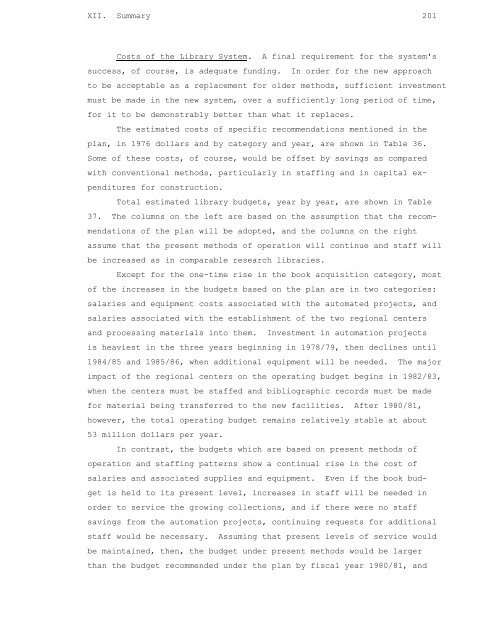The University of California Libraries: A Plan for Development (1977)
The University of California Libraries: A Plan for Development (1977)
The University of California Libraries: A Plan for Development (1977)
Create successful ePaper yourself
Turn your PDF publications into a flip-book with our unique Google optimized e-Paper software.
XII. Summary 201<br />
Costs <strong>of</strong> the Library System. A final requirement <strong>for</strong> the system's<br />
success, <strong>of</strong> course, is adequate funding. In order <strong>for</strong> the new approach<br />
to be acceptable as a replacement <strong>for</strong> older methods, sufficient investment<br />
must be made in the new system, over a sufficiently long period <strong>of</strong> time,<br />
<strong>for</strong> it to be demonstrably better than what it replaces.<br />
<strong>The</strong> estimated costs <strong>of</strong> specific recommendations mentioned in the<br />
plan, in 1976 dollars and by category and year, are shown in Table 36.<br />
Some <strong>of</strong> these costs, <strong>of</strong> course, would be <strong>of</strong>fset by savings as compared<br />
with conventional methods, particularly in staffing and in capital expenditures<br />
<strong>for</strong> construction.<br />
Total estimated library budgets, year by year, are shown in Table<br />
37. <strong>The</strong> columns on the left are based on the assumption that the recommendations<br />
<strong>of</strong> the plan will be adopted, and the columns on the right<br />
assume that the present methods <strong>of</strong> operation will continue and staff will<br />
be increased as in comparable research libraries.<br />
Except <strong>for</strong> the one-time rise in the book acquisition category, most<br />
<strong>of</strong> the increases in the budgets based on the plan are in two categories:<br />
salaries and equipment costs associated with the automated projects, and<br />
salaries associated with the establishment <strong>of</strong> the two regional centers<br />
and processing materials into them. Investment in automation projects<br />
is heaviest in the three years beginning in 1978/79, then declines until<br />
1984/85 and 1985/86, when additional equipment will be needed. <strong>The</strong> major<br />
impact <strong>of</strong> the regional centers on the operating budget begins in 1982/83,<br />
when the centers must be staffed and bibliographic records must be made<br />
<strong>for</strong> material being transferred to the new facilities. After 1980/81,<br />
however, the total operating budget remains relatively stable at about<br />
53 million dollars per year.<br />
In contrast, the budgets which are based on present methods <strong>of</strong><br />
operation and staffing patterns show a continual rise in the cost <strong>of</strong><br />
salaries and associated supplies and equipment. Even if the book budget<br />
is held to its present level, increases in staff will be needed in<br />
order to service the growing collections, and if there were no staff<br />
savings from the automation projects, continuing requests <strong>for</strong> additional<br />
staff would be necessary. Assuming that present levels <strong>of</strong> service would<br />
be maintained, then, the budget under present methods would be larger<br />
than the budget recommended under the plan by fiscal year 1980/81, and
















